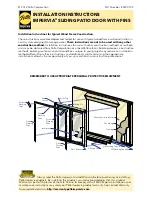
CL33700 PWI/PIP Series Cylindrical Lock
20
Copyright © 2014 Corbin Russwin, Inc., an ASSA ABLOY Group company.
All rights reserved. Reproduction in whole or in part without the
express written permission of Corbin Russwin, Inc. is prohibited.
6) Operationial Check
IMPORTANT
: Be sure to test functions prior to closing door.
In all cases, perform the following checks:
1. Ensure that inside lever retracts latch (and deadbolt for deadbolt
functions).
• For units with cylinders, the following checks apply:
Insert key into cylinder and rotate
a. There should be no friction against lock case, wire harness,
or any other obstructions. If friction or binding occurs, read-
just cylinder and wiring harness to eliminate issues.
b. The key should retract the latch and the key should rotate
freely.
c. The key should extend and retract the deadbolt.
• For units without a keypad, add card using LCT
software and test.
• For units with a keypad, add pin and card using LCT software
and test.
2. LED signalling:
• After using a valid credential, a green flash followed by three
fast amber flashes indicates a low power condition.
Check the input voltage.
If the input voltage is low, disconnect the lock from the power
source and check the power source
voltage. If the power source voltage is correct,
inspect the lock wiring for a possible short.
• If the lock loses power, it will flash rapid amber
for approximately one minute.
After that, the lock will no longer be functional.
3. When you have completed the tests, close the door to ensure
latchbolt and deadbolt fully extend into strike plate without binding.


































